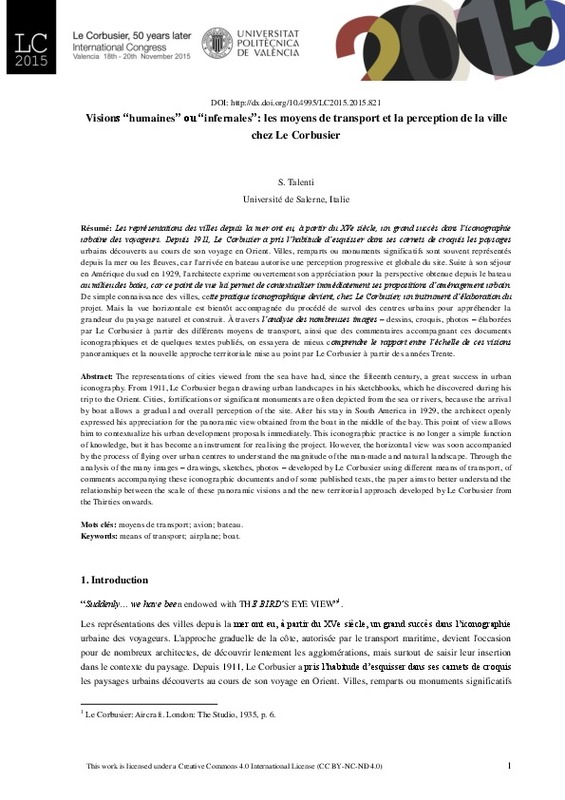JavaScript is disabled for your browser. Some features of this site may not work without it.
Buscar en RiuNet
Listar
Mi cuenta
Estadísticas
Ayuda RiuNet
Admin. UPV
Visions “humaines” ou “infernales”: les moyens de transport et la perception de la ville chez Le Corbusier
Mostrar el registro sencillo del ítem
Ficheros en el ítem
| dc.contributor.author | Talenti, Simona
|
es_ES |
| dc.date.accessioned | 2017-09-12T07:25:59Z | |
| dc.date.available | 2017-09-12T07:25:59Z | |
| dc.date.issued | 2016-03-03 | |
| dc.identifier.isbn | 9788490483732 | |
| dc.identifier.uri | http://hdl.handle.net/10251/87073 | |
| dc.description.abstract | [EN] The representations of cities viewed from the sea have had, since the fifteenth century, a great success in urban iconography. From 1911, Le Corbusier began drawing urban landscapes in his sketchbooks, which he discovered during his trip to the Orient. Cities, fortifications or significant monuments are often depicted from the sea or rivers, because the arrival by boat allows a gradual and overall perception of the site. After his stay in South America in 1929, the architect openly expressed his appreciation for the panoramic view obtained from the boat in the middle of the bay. This point of view allows him to contextualize his urban development proposals immediately. This iconographic practice is no longer a simple function of knowledge, but it has become an instrument for realising the project. However, the horizontal view was soon accompanied by the process of flying over urban centres to understand the magnitude of the man-made and natural landscape. Through the analysis of the many images – drawings, sketches, photos – developed by Le Corbusier using different means of transport, of comments accompanying these iconographic documents and of some published texts, the paper aims to better understand the relationship between the scale of these panoramic visions and the new territorial approach developed by Le Corbusier from the Thirties onwards. | es_ES |
| dc.description.abstract | [ES] Les représentations des villes depuis la mer ont eu, à partir du XVe siècle, un grand succès dans l’iconographie urbaine des voyageurs. Depuis 1911, Le Corbusier a pris l’habitude d’esquisser dans ses carnets de croquis les paysages urbains découverts au cours de son voyage en Orient. Villes, remparts ou monuments significatifs sont souvent représentés depuis la mer ou les fleuves, car l'arrivée en bateau autorise une perception progressive et globale du site. Suite à son séjour en Amérique du sud en 1929, l'architecte exprime ouvertement son appréciation pour la perspective obtenue depuis le bateau au milieu des baies, car ce point de vue lui permet de contextualiser immédiatement ses propositions d’aménagement urbain. De simple connaissance des villes, cette pratique iconographique devient, chez Le Corbusier, un instrument d’élaboration du projet. Mais la vue horizontale est bientôt accompagnée du procédé de survol des centres urbains pour appréhender la grandeur du paysage naturel et construit. À travers l’analyse des nombreuses images – dessins, croquis, photos – élaborées par Le Corbusier à partir des différents moyens de transport, ainsi que des commentaires accompagnant ces documents iconographiques et de quelques textes publiés, on essayera de mieux comprendre le rapport entre l’échelle de ces visions panoramiques et la nouvelle approche territoriale mise au point par Le Corbusier à partir des années Trente. | es_ES |
| dc.format.extent | 20 | es_ES |
| dc.language | Francés | es_ES |
| dc.publisher | Editorial Universitat Politècnica de València | es_ES |
| dc.relation.ispartof | LE CORBUSIER. 50 AÑOS DESPUÉS | es_ES |
| dc.rights | Reconocimiento - No comercial - Sin obra derivada (by-nc-nd) | es_ES |
| dc.subject | architecture | es_ES |
| dc.subject | le corbusier | es_ES |
| dc.subject | modern movement | es_ES |
| dc.title | Visions “humaines” ou “infernales”: les moyens de transport et la perception de la ville chez Le Corbusier | es_ES |
| dc.type | Capítulo de libro | es_ES |
| dc.type | Comunicación en congreso | es_ES |
| dc.identifier.doi | 10.4995/LC2015.2015.821 | |
| dc.rights.accessRights | Abierto | es_ES |
| dc.description.bibliographicCitation | Talenti, S. (2016). Visions “humaines” ou “infernales”: les moyens de transport et la perception de la ville chez Le Corbusier. En LE CORBUSIER. 50 AÑOS DESPUÉS. Editorial Universitat Politècnica de València. 2184-2204. https://doi.org/10.4995/LC2015.2015.821 | es_ES |
| dc.description.accrualMethod | OCS | es_ES |
| dc.relation.conferencename | LC2015 - Le Corbusier, 50 years later | es_ES |
| dc.relation.conferencedate | November 18-20,2015 | es_ES |
| dc.relation.conferenceplace | Valencia, Spain | es_ES |
| dc.relation.publisherversion | http://ocs.editorial.upv.es/index.php/LC2015/LC2015/paper/view/821 | es_ES |
| dc.description.upvformatpinicio | 2184 | es_ES |
| dc.description.upvformatpfin | 2204 | es_ES |
| dc.type.version | info:eu-repo/semantics/publishedVersion | es_ES |
| dc.relation.pasarela | OCS\821 | es_ES |








